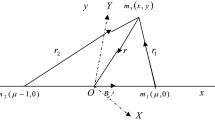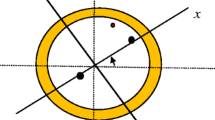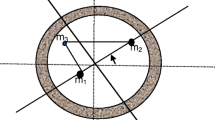Abstract
In this paper the equations of motion of the circular restricted three body problem is modified to include radiation of the bigger primary, triaxiality of the smaller primary; and gravitational potential created by a belt. We have obtained that due to the perturbations, the locations of the triangular libration points and their linear stability are affected. The points move towards the bigger primary due to the resultant effect of the perturbations. Triangular libration points are stable for \(0<\mu <\mu _c\) and unstable for \(\mu _c \le \mu \le \frac{1}{2}\), where \(\mu _c\) is the critical mass ratio affected by the perturbations. The radiation of the bigger primary and triaxiality of the smaller primary have destabilizing propensities, whereas the potential created by the belt has stabilizing propensity. This model could be applied in the study of the motion of a dust particle near radiating -triaxial binary system surrounded by a belt.
Similar content being viewed by others
References
Battista, E., Dell’Agnello, S., Esposito, G., Simo, J.: On the quantum effects on noncollinear Lagrangian points and displaced periodic orbits in the Earth-Moon system. 3,1–30 (2015). arXiv:1501.0272
Bevis, N., Magueijo, J., Trenkel, C., Kemble, S.: MONDian three-body predictions for LISA Pathfinder. Class. Quantum Gravity 27(21), 215014 (2010)
Bhatnagar, K.B., Chawla, J.M.: A study of the Lagrangian points in the photogravitational restricted three-body problem. Indian J. Pure Appl. Math. 10(11), 1443–1451 (1979)
Greaves, J.S., Holland, W.S., Moriarty-Schieven, G., Jenness, T., Dent, W.R.F., Zuckerman, B., Mccarthy, C., Webb, R.A., Butner, H.M., Gear, W.K., Walker, H.J.: A dust ring around \(\epsilon \) Eridani: analog to the young Solar System. Astrophys. J. 506, L133–L137 (1998)
Guéron, E.: A semi-relativistic approach to the circular restricted three-body problem and a numerical experiment around the 3:2 resonance. Class. Quantum Gravity 23(3), 673–682 (2006)
Iorio, L.: Evidence of the gravitomagnetic field of Mars. Class. Quantum Gravity 23(17), 5451–5454 (2006)
Iorio, L.: An assessment of the systematic uncertainty in present and future tests of the lense-thirring effect with satellite laser ranging. Space Sci. Rev. 148(1–4), 363–381 (2009)
Iorio, L.: Perturbed steller motions around the rotating black hole Sgr A* for generic orientation of its spin axis. Phys. Rev. D 84(12), 124001 (2011)
Iorio, L.: Orbital perturbations due to massive rings. Earth Moond Planets 108(3–4), 189–217 (2012)
Iorio, L.: Orbital motions as gradiometers for post-Newtonian tidal effects. Front. Astron. Space Sci. (2014). doi:10.3389/fspas.2014.00003
Iorio, L.: Gravitational anomalies in the solar system. Int. J. Mod. Phys. D (2015) (in press). arXiv:1412.7673
Iorio, L., Lichtenegger, H.I.M., Ruggiero, M.L., Corda, C.: Phenomenology of the Lense–Thirring effect in the Solar System. Astrophys. Space Sci. 331(2), 351–395 (2011)
Iorio, L., Ruggiero, M.L., Corda, C.: Novel consideration about the error budget of the LAGEOES-based tests of frame-dragging with GRACE geopotential models. Acta Astron. 91, 141–148 (2013)
Jain, S., Kumar, A., Bhatnagar, K.B.: Periodic orbits around the collinear libration points in the restricted three body problem when the smaller primary is a triaxial rigid body : Sun-Earth case. Bull. Astron. Soc. India 34, 211–223 (2006)
Jiang, I.G., Yeh, L.C.: Bifurcation for dynamical systems of planet–belt interaction. Int. J. Bifurc. Chaos 13(3), 617–630 (2003)
Jiang, I.G., Yeh, L.C.: The drag-induced resonant capture for Kuiper belt objects. Mon. Not. R. Astron. Soc. 355, L29–L32 (2004a)
Jiang, I.G., Yeh, L.C.: On the chaotic orbits of disk-star-planet systems. Astron. J. 128, 923–932 (2004b)
Kalas, P., Fitzgerald, M.P., Graham, J.R.: Discovery of Extreme asymmetry in the debris disk surrounding HD 15115. Astrophys. J. 661, L85–L88 (2007)
Khanna, M., Bhatnagar, K.B.: Existence and stability of libration points in the restricted three body problem when the smaller primary is a triaxial rigid body and the bigger one an oblate sheriods. Indian J. Pure Appl. Math. 30(7), 721–733 (1999)
Magueijo, J., Mozaffari, A.: Case for testing modified Newtonian dynamics using LISA pathfinder. Phys. Rev. D 85(4), 43527 (2012)
Miyamoto, M., Nagai, R.: Three-dimensional models for the distribution of mass in galaxies. Publ. Astron. Soc. Jpn. 27, 533–543 (1975)
Poynting, J.H.: Radiation in the solar system: its effect on temperature and its pressure on small bodies. Philos. Trans. R. Soc. Lond. 202, 525–552 (1903)
Radzievskii, V.V.: The restricted problem of three-body taking account of light pressure. Astron. J. Zh 27, 250–256 (1950)
Renzetti, G.: Exact geodetic precession of the orbit of a two-body gyroscope in geodesic motion about a third mass. Earth Moon Planets 109(1–4), 55–59 (2012)
Renzetti, G.: Satellite orbital precessions caused by the octupolar mass moment of a non-spherical body arbitrarily oriented in space. J. Astrophys. Astron. 34(4), 341–348 (2013)
Renzetti, G.: Satellite orbital precessions caused by the first odd zonal \(\text{ J }_{3}\) multipole of a non-spherical body arbitrarily oriented in space. Astrophys. Space Sci. 352(2), 493–496 (2014)
Rozelot, J.P., Damiani, C.: History of solar oblateness measurements and interpretation. Eur. Phys. J. H 36(3), 407–436 (2011)
Sharma, R.K., Taqvi, Z.A., Bhatnagar, K.B.: Existence and stability of libration points in the restricted three body problem when the bigger primary is a triaxial rigid body and source of radiation. Indian J. Pure Appl. Math. 32(2), 255–266 (2001)
Sharma, R.K., Taqvi, Z.A., Bhatnagar, K.B.: Existence and stability of libration points in the restricted three body problem when the primaries are triaxial rigid bodies. Celest. Mech. Dyn. Astron. 79(2), 119–133 (2001)
Sharma, R.K., Taqvi, Z.A., Bhatnagar, K.B.: Existence and stability of libration points in the restricted three body problem when the primaries are triaxial rigid bodies and source of radiations. Indian J. Pure Appl. Math. 32(7), 981–994 (2001)
Schnittman, J.D.: The Lagrange equilibrium points \(\text{ L }_{4}\) and \(\text{ L }_{5}\) in black hole binary system. Astrophys. J. 724(1), 39–48 (2010)
Singh, J.: The equilibrium points in the perturbed R3BP with triaxial and luminous primaries. Astrophys. Space Sci. 346, 41–50 (2013)
Singh, J., Begha, J.M.: Stability of equilibrium points in the generalized perturbed restricted three-body problem. Astrophys. Space Sci. 331, 511–519 (2011)
Singh, J., Taura, J.J.: Motion in the generalized restricted three-body problem. Astrophys. Space Sci. 343(1), 95–106 (2013)
Singh, J., Taura, J.J.: Effects of zonal harmonics and a circular cluster of material points on the stability of triangular equilibrium points in the R3BP. Astrophys. Space Sci. 350(1), 127–132 (2014)
Singh, J., Taura, J.J.: Combined effect of oblateness, radiation and a circular cluster of material points on the stability of triangular libration points in the R3BP. Astrophys. Space Sci. 351(2), 499–506 (2014)
Singh, J., Taura, J.J.: Stability of triangular equilibrium points in the photogravitational restricted three-body problem with oblateness and potential from a belt. J. Astrophys. Astron. 35, 107–119 (2014)
Szebehely, V.: Theory of Orbits: The Restricted Problem of Three Bodies. Academic Press, New York (1967)
Trilling, D.E., Stansberry’, J.A., Stapelfeldt, K.R., Rieke, G.H., Su, K.Y.L., Gray, R.O., Corbally, C.J., Bryden, G., Chen, C.H., Boden, A., Beichman, C.A.: Debris disks in main-sequence binary systems. Astrophys. J. 658, 1289–1311 (2007)
Yeh, L.C., Jiang, I.G.: On the Chermnykh-like problems: II. The equilibrium points. Astrophys. Space Sci. 306, 189–200 (2006)
Zhao, H., Li, B., Bienaymé, O.: Modified Kepler’s law, escape speed and two-body problem in MOND-like theories. Phys. Rev. D 82(10), 103001 (2010)
Author information
Authors and Affiliations
Corresponding author
Rights and permissions
About this article
Cite this article
Singh, J., Taura, J.J. Triangular Libration Points in the CR3BP with Radiation, Triaxiality and Potential from a Belt. Differ Equ Dyn Syst 25, 385–396 (2017). https://doi.org/10.1007/s12591-015-0243-0
Published:
Issue Date:
DOI: https://doi.org/10.1007/s12591-015-0243-0




